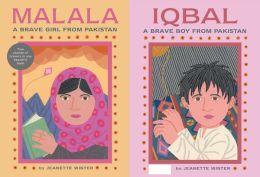

The story of Malala Yousafzai, the 17-year-old Pakistani pro-education activist who survived the Taliban's attempt on her life and is the youngest-ever winner of the Nobel Peace Prize, is paired with that of Iqbal Masih, a Pakistani boy who escaped slavery, became an anti-childhood-bondage activist and was shot and killed at the age of 12 in 1995. The front-to-back story features Malala, the reverse tells the story of Iqbal, and Winter smoothly joins them together in the center spread.
Malala's story opens as her would-be assassin descends upon her school van, then backtracks to tell how Malala spoke out repeatedly against the Taliban's ban on educating girls. As kites bob overhead, Malala attends school alongside girls wearing bright, beautifully patterned hijabs, and stands on a crate so that she can see over a podium to deliver a speech. Winter describes the Taliban attack, and Malala's miraculous survival, in simple, child-appropriate language: "He shoots Malala. The van rushes her to the small hospital in Swat Valley. A helicopter lifts her to a bigger hospital far away." Malala's story concludes with her 2013 address to the United Nations, as a kite flies above her, a symbol of rising above suffocating strictures.
Iqbal is four years old when a carpet boss yanks him from playing with his kite and shackles him to a loom, bonded by a $12 loan his parents took out. Iqbal secretly weaves an image of a kite into his carpet pattern. After six years, the boy learns that Peshgi--the loans that create bondage--have been outlawed. He starts school and speaks out about the evils of child slavery, eventually traveling to the U.S. to give a speech. Threatened by the carpet industry, Iqbal refuses to be silenced--until he is killed while riding his bicycle at age 12. Sensitive to a child audience, Winter depicts an explosion behind a building, and one bicycle wheel; 800 mourners attend his funeral. A kite ascends, unfettered, into a purple sky.
In the luminous full-page center spread, Malala and Iqbal stand on mountains, gazing at each other under a starry sky, flying kites that dance across to the other's side. Malala keeps a firm grasp on her kite string, while Iqbal releases his. Even as Iqbal's story saddens us, we must remember him in conjunction with Malala, living proof that hope thrives alongside death. Coupling the stories creates a whole greater than the sum of its parts. Winter has created a radiant, transcendent book. --Allie Jane Bruce, children's librarian, Bank Street College of Education
Shelf Talker: The biographies of two children's rights activists, Malala Yousafzai and Iqbal Masih, together in one book; their stories balance each other to create a radiant whole.

